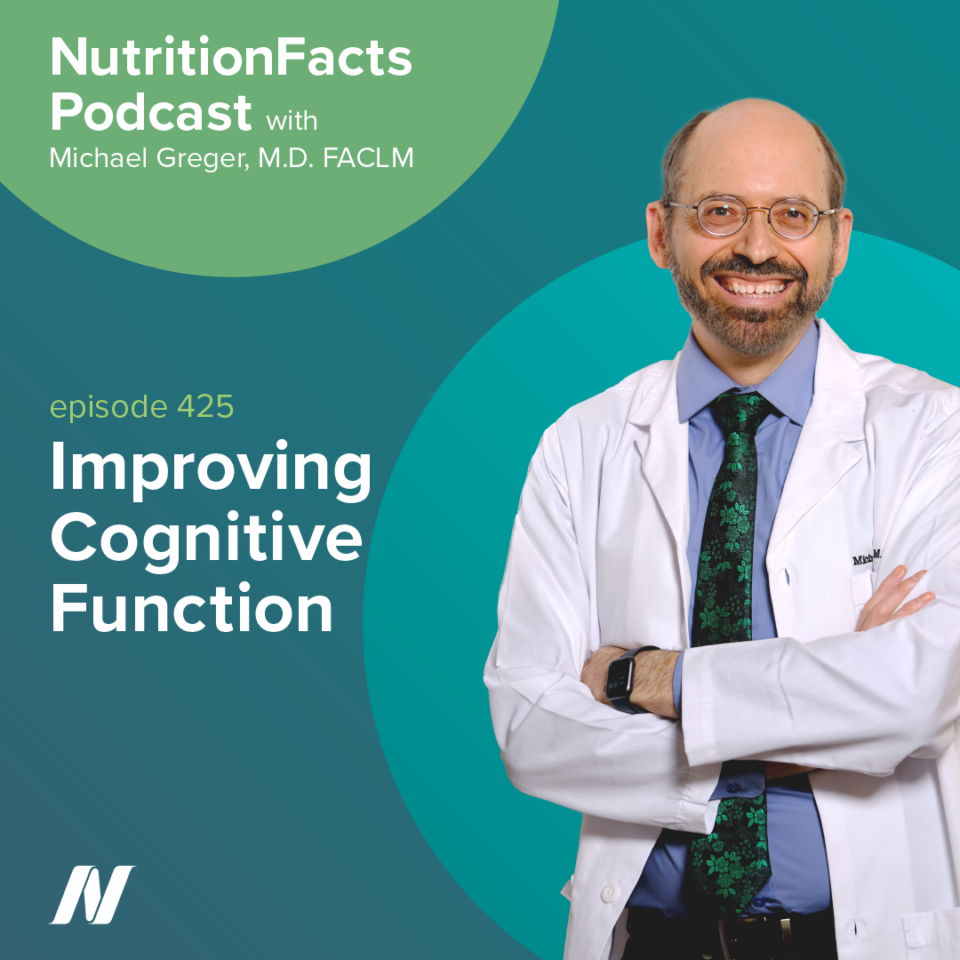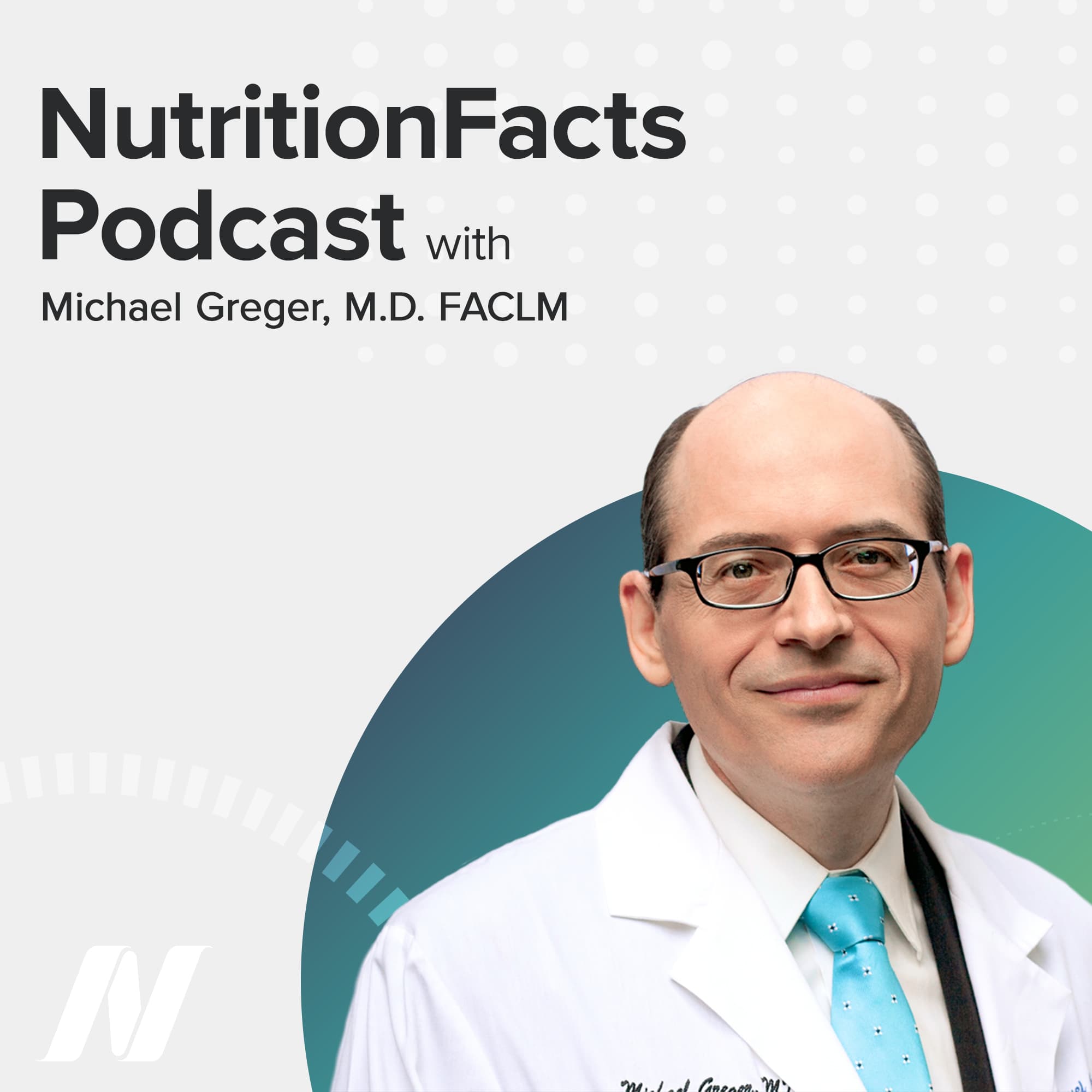The mind is a terrible thing to waste. So, today, we look at ways to improve our cognitive function, and we start with a new study that measured the relationship between exercise and dementia prevention.
Based on a meta-analysis of 20 studies, mental performance may be improved with even modest weight loss among overweight individuals, though that may be due not to the weight loss per se, but rather the prescribed exercise. For example, one study randomized obese elders to one of four groups for a year: a weight-loss diet alone, exercise without weight loss, both, or neither. Compared to the control group that did neither, global cognition improved in all the three other groups, but while weight loss and exercise beat out weight loss alone, weight loss and exercise didn’t beat the exercise alone, suggesting that exercise is the most potent component.
The American College of Sports Medicine cites meta-analyses of dozens of prospective studies following tens of thousands of people for years that suggest that those who are active have a 38 percent lower risk of cognitive decline, and a 39 percent lower risk of developing Alzheimer’s disease. And, apparently, the more the better. Every extra 500 calories expended a week appears to correlate with an additional 10 percent drop in dementia risk. However, even light physical activity, such as low-intensity walking, or how yoga and tai chi are often practiced by older adults, has been associated with at least some sort of cognitive gain in about half of the studies done to date.
If the relationship between exercise and dementia prevention is cause-and-effect, as much as 20 percent of all cases of Alzheimer’s disease in Western countries may be attributable to physical inactivity. That would mean more than a million cases of Alzheimer’s just in the U.S. alone. As with all observational data, though, there’s the potential for confounding or reverse causation. Maybe there’s a shared factor causing both, such as atherosclerosis, contributing to both inactivity and dementia, or maybe those genetically predisposed to exercise a lot also have a more robust cognitive reserve (though a Mendelian randomization study failed to find this).
Instead of inactivity leading to dementia, dementia could lead to inactivity. Prospective studies following people over time can show the inactivity does precede the dementia, but both mental and physical activity can start declining years before a diagnosis. When researchers looked closely at the data, only inactivity less than 10 years before the diagnosis was associated with inactivity, suggesting the causality may indeed be backward. When put to the test, interventional trials show physical activity can be increased in dementia patients, which can improve physical fitness, but disappointingly did not slow cognitive impairment.
Perhaps we’re just not catching people early enough? Adults with either normal cognition or mild cognitive impairment randomized to exercise training tend to improve their cognition, compared to those ending up in the less active control groups. A slight majority of studies that concurrently tracked brain imaging found those randomized to exercise experienced a beneficial effect on overall brain volume, as well as specifically the hippocampus, a part of the brain that plays a critical role in memory formation and for which atrophy predicts memory decline and dementia.
The seminal study, “Exercise training increases size of hippocampus and improves memory,” randomized older adults to either a year of supervised moderate aerobic exercise (walking), or a control group, which instead involved a year of stretching and toning classes. On average, the hippocampus volume of those in the control group shrank 1.4 percent, which is consistent with the 1 to 2 percent annual shrinkage typical of old age. In contrast, over that same year in the walking group, their hippocampus volume increased 2 percent, which is like adding a year or two of brain volume (though may subsequently shrink back to baseline in as few as six weeks of inactivity; so, you got to keep it up).
A similar study that added a third group—a resistance training arm—found a similar aerobic training reversal of age-related shrinkage in the memory centers, compared to the balance and toning control group, but unfortunately there was no benefit seen in the nonaerobic strength-training group. It’s unclear exactly which type of exercise is best, but the cognitive benefit of aerobic training appears to be larger than resistance training. In most of the randomized controlled trials of older adults, walking was the most frequently chosen mode of exercise. The best volume, duration, frequency, or intensity is also unknown. Based on a meta-analysis of nearly a hundred randomized controlled trials, more important than session duration, weekly frequency, program duration, or intensity, may be total training time. However studies spliced it up, it appeared to take exercising for a total of at least 52 hours before a cognitive benefit can be established.
In our next story, we look at non-drug, non-supplement, non-lifestyle approaches to dementia prevention and treatment.
In my book, How Not to Age, I discuss the role of drugs and supplements and focus on diet and lifestyle approaches to the prevention and treatment of cognitive decline, but there are a few common non-drug, non-supplement, non-lifestyle approaches to dementia treatment––for example, cognitive stimulation therapy, which typically involves group activities and social interaction. There have been at least 44 randomized controlled trials of cognitive stimulation including thousands of participants. ADAS-Cog, short for Alzheimer’s Disease Assessment Scale – Cognitive subscale, is the most commonly used measure of cognition in clinical trials of dementia treatment. A clinically relevant improvement is often defined as a reduction of four or more points on the ADAS-Cog measure. Regrettably, the attenuation of cognitive decline for most of the cognitive stimulation studies averaged only about two points.
You could argue any improvement is better than nothing, but unfortunately, the cognitive effects don’t appear to generalize to helping with everyday life situations. You can train people to get better at a computerized “brain game,” but that doesn’t necessarily translate to other arenas. Also, the marginal improvements are temporary. They don’t appear to persist once the intervention period is over.
While cognitive stimulation therapy may have no significant overall effect on quality of life, any kind of group therapy has been shown to improve psychological well-being. As social creatures, social participation is important for mental health throughout the life course, but there is insufficient evidence that it can improve or prevent cognitive dysfunction. Dementia is associated with social isolation, but this may be reverse causation, where the dementia leads to social withdrawal, instead of the other way around.
The same issue comes up all the time with those advocating for “use-it-or-lose-it” mental stimulation to forestall decline. For example, this review in a peer-reviewed aging journal suggested that “if a person solves crosswords four times a week, they can reduce their risk of dementia by 47 percent.” Yes, doing frequent crossword puzzles is associated with lower subsequent dementia risk, but isn’t it more likely that those on the verge of a dementia diagnosis are less likely to be doing crossword puzzles, as a result of their declining cognitive abilities?
Music therapy presents a similar story of improving well-being without necessarily affecting cognition. Even in late stages of dementia, when verbal communication is lost, music can be enjoyed. However, it does not seem to improve brain function. Most (five out of seven) meta-analyses of the 40+ interventional clinical trials of music therapy for people with dementia found no cognitive benefits. And, the few studies that did found the effect was short-lived, disappearing after one to three months. Even though cognition doesn’t seem to be affected, there still may be positive effects in terms of reducing agitation and improving mood and socialization.
One of the kookiest treatments I ran across was cryotherapy, also known as cryostimulation. Those with mild cognitive impairment randomized to short-term exposures to extremely cold temperatures experienced a transient boost in general cognitive functioning (no longer apparent two weeks after daily sessions ended). Study subjects in shorts and a t-shirt were exposed to 58 degrees below zero (-50 C) for two minutes. No, wait, that was the placebo control group exposed to “noncryogenic” temperatures. How low did the experimental group go? Two minutes at more like 200 degrees below zero (-130 C).

 Previous Podcast
Previous Podcast Next Podcast
Next Podcast